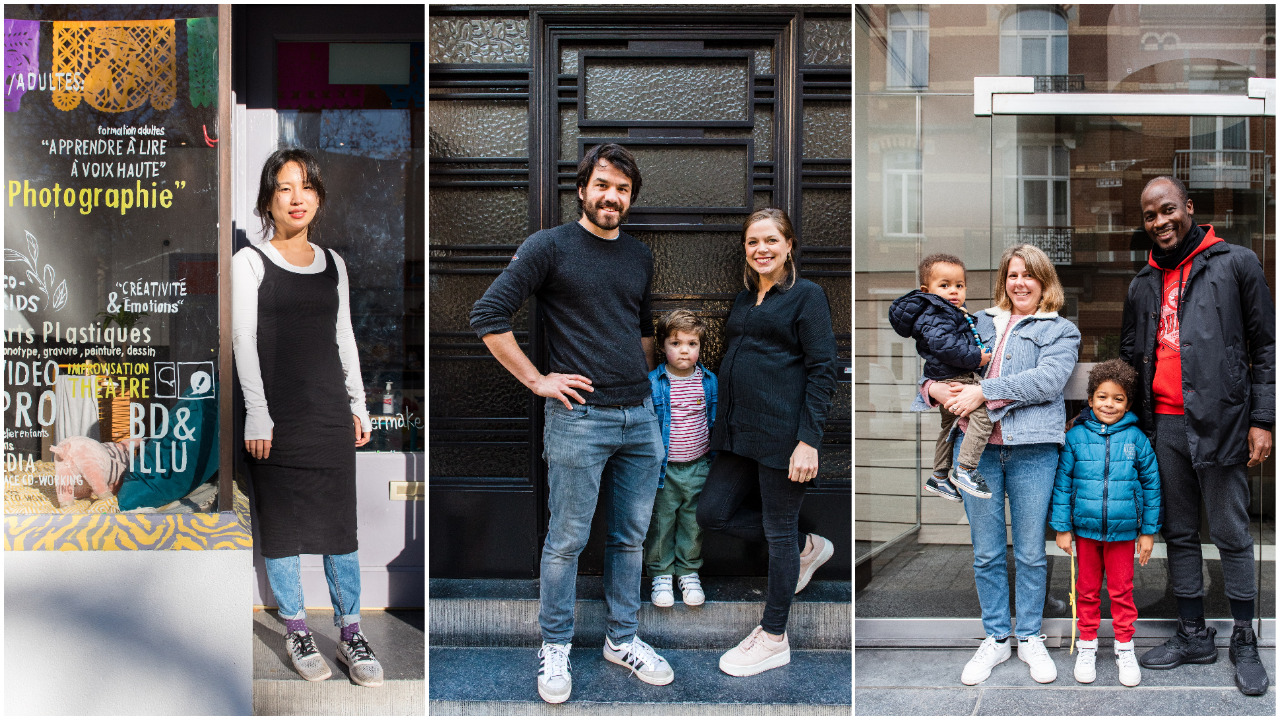- Daily & Weekly newsletters
- Buy & download The Bulletin
- Comment on our articles
Lockdown Portraits: Photographer captures special year in life of Brussels families
Like the rest of us, Sophie Lenoir took to her bike for a little exercise and fresh air during the lockdown last spring. And she began to think about all those families behind all those locked doors.
A professional photographer, she put out a call on a Facebook group devoted to the Laeken neighbourhood, where she lives. She wanted to photograph those families in front of their homes. And people responded like gangbusters.
She started in Laeken and soon branched out. Now, nearly a year later, she has covered all 19 of Brussels’ municipalities in 500 photographs for a project she calls Lockdown Portraits. An exhibition devoted to Ixelles residents is currently on view at the Boondael Chapel.
“I began as a freelancer photographer just before the pandemic hit,” says Lenoir, who moved to the capital from the Flemish region 10 years ago. “I was doing weddings and conferences – the kind of events that immediately shut down as soon as the lockdown began. So yeah, perfect timing!”
Documenting a crisis
She found herself out of work but highly motivated to get the business she had just started up and running. “I cycled around my own neighbourhood and took photos of my neighbours. I didn’t see it as a big project in the beginning, but people were very enthusiastic about it. And over time I started getting requests from all over Brussels.”
The portraits are of whoever is living inside the house. They are all taken in the same way – full body, from head to toe – so that no one family appears more important than another. Each photo is accompanied by a statement written up by the family itself.
“I gave them carte blanche on what to write, as long as it was about the lockdown,” Lenoir explains. Statements could be written in French, Dutch or English, and only the originals are hanging with the photos in the Boondael Chapel; no translations were made.
Seeing many of the photos altogether is a sometimes startling example of the incredible diversity of Brussels. It’s also a record of the length of the pandemic.
At the beginning of the Lockdown Portraits project, she was just having fun, she says. “It was only over time that I realised what the value of those photographs was. It’s now been a year since we’ve been in this situation, and I realise I’m documenting this period. We are going through all the seasons, you can see that in the photos, the clothing changes, the colours change. The testimonies change from talking about the Easter holiday to the summer holiday to Christmas.”

Attitudes changed as well, as the measures to control the spread of the virus dragged on. “I started in Laeken and then I went to Schaerbeek. In Schaerbeek, I was welcomed with so much enthusiasm, you could tell that people were happy to see me. Or maybe they were just happy to see another face than the one they were living with 24 hours a day.”
The families in Schaerbeek would thank her, she says, with little gifts, like cake, beer or wine. “I really loved going there for the general feeling of solidarity and energy, and that’s something quite unique that I haven’t really found in the other communes.”
At first she thought it was about the municipality; Schaerbeek was just special. “But it could be the timing, because it was early in the first lockdown. It was all very new. As I continued the project in the other communes, there wasn’t the same energy. I think because people were growing tired of the situation. They were still friendly, of course, but the dynamics and that energy had kind of faded.”
More important than municipal borders, she notes, are streets and blocks. “There are some places where the lockdown really created a connection between the neighbours. In the first few minutes that I spoke with them, they always brought it up; you could see that it had brought a really positive vibe to that neighbourhood. It makes sense because in times of isolation being surrounded by good neighbours is important.”
Empty Brussels
Besides the current exhibition in Ixelles, there was also one focused on the Woluwe municipalities last autumn. And there are more to follow. The portraits are also joined by some photos Lenoir shot of empty streets and squares. It has resulted in a series called Empty Brussels. “I went to iconic places, like Grand Place. It was so special to see places that are usually super crowded with tourists completely empty.”
Lenoir’s Lockdown Portraits is ongoing. “I want to continue until the end of the lockdown. I don’t know when this situation will really end, but I want to continue at least until we get back to a more-or-less normal life.” When it’s all finished, she plans to publish a book with all the photos and testimonials in chronological order.
Lenoir is also one of the people behind the Everything Brussels website, a travel guide to the capital in English and Dutch.
Lockdown Portraits: Ixelles, until 28 February, Chapelle de Boondael, Square du Vieux Tilleul 10
Photos ©Sophie Lenoir


















